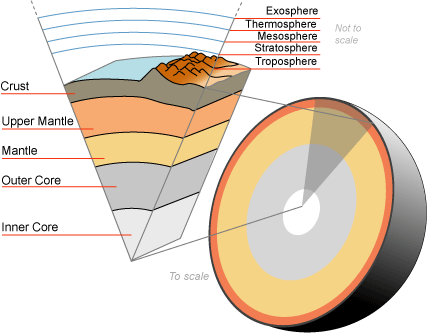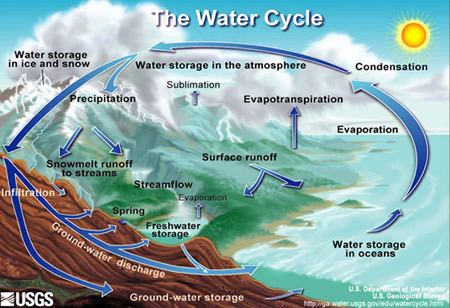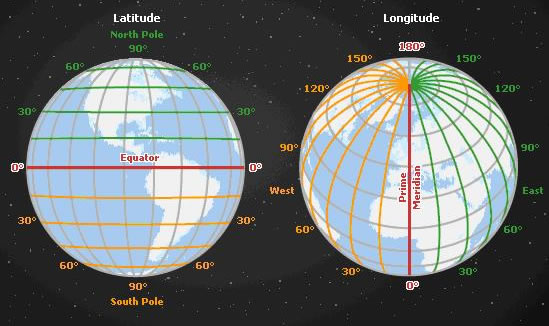 username@email.com
username@email.com
In the next lesson, we will review the make-up of our planet and the different layers of the Earth and its atmosphere.
We will also look at the Earth’s attributes and review the concepts of latitude and longitude on the Earth’s surface.
We just finished covering the life cycle of stars. We also looked at the layers of the sun.
The Earth is divided into four main components or spheres: the lithosphere, the hydrosphere, the atmosphere, and the biosphere. Each sphere is a part of the larger system and all the parts are interconnected, working together as a whole. Any change in one sphere causes changes in one or more of the other spheres. Matter and energy constantly move from one sphere to another. For example, the water system cyclically moves water and energy from the oceans, to the atmosphere, the land, and back to the oceans. The sun supplies almost all of the energy for Earth’s processes, both biotic and abiotic. For example, the sun supplies the energy to keep the water cycle in constant motion. The sun’s heat and light energy is transferred to the Earth via radiation, a method in which energy can travel through space. The suns’ radiation warms the surface of the Earth and provides the light energy for green plants. The remainder of the energy is a much smaller amount by comparison. It comes from the Earth’s interior and is transferred into Earth’s system primarily through volcanic eruptions.
All the systems of Earth are interlinked and interdependent. Earth’s solid rocky layer is called the lithosphere. Earth’s water bodies (rivers, oceans, lakes, and ice) form the hydrosphere; the oceans affect the temperature of the atmosphere, and flowing rivers shape the topography of the lithosphere. All habitats for living organisms on Earth, whether in air, in water, on land, or underground, form the biosphere. Plant growth constantly changes the surface of the lithosphere and gases expelled by plants affect the atmosphere. Storms in the atmosphere bring rains that change the surface of the lithosphere. The outermost sphere of the Earth is called the atmosphere and consists of the mixture of gases that surrounds the planet. All spheres are tightly interrelated and constantly affect each other.
Surrounding the Earth’s surface is an envelope of gases called the atmosphere. Earth’s atmosphere is made up mostly of a mixture of nitrogen, and oxygen, smaller amounts of carbon dioxide, hydrogen and inert gases, some liquids and their vapors and solids. The most abundant gas in the atmosphere is nitrogen, which accounts for approximately 78% of the air we breathe. The next most abundant gas in the atmosphere is oxygen, which accounts for 21% of our air. The remaining 1% of the atmosphere is made up of (in decreasing order) argon, carbon dioxide, neon, helium, methane, krypton, and hydrogen. The atmosphere is relatively thin, only extending a few hundred kilometers above the Earth’s surface.
The atmosphere supports the conditions for life on Earth, making the Earth suitable for living things. Just like all the other ‘spheres,’ the atmosphere is constantly changing with gases being exchanged between and among the different Earth systems. The atmosphere also traps water and heat near the surface of the Earth. The heat held near the Earth makes it possible for water to exist as a liquid and provides the temperature ranges suitable for life, as we know it. The atmosphere promotes a stable environment by preventing excessive solar radiation from reaching the Earth and protects the Earth’s surface from most meteor impacts.
The atmosphere is comprised of a series of four main layers of different temperatures: the troposphere, the stratosphere, the mesosphere and the thermosphere. The thermosphere is further divided into the ionosphere and the exosphere.

The stratosphere is the next layer above the troposphere and extends upward about 50 kilometers. It contains the ozone layer and is the layer that absorbs the most ultraviolet radiation. The lower regions of the stratosphere are the same temperature as the top of the troposphere. Surprisingly, as the higher the layer the warmer the temperature. This is because when ozone absorbs energy from the sun heat is generated, thus warming the surrounding air.
The mesosphere is the third layer of the Earth’s atmosphere. It is the layer that protects the Earth’s surface from being struck by most meteoroids. When you see a shooting star, you are seeing a trail of hot gases glowing in the mesosphere. The mesosphere is marked by a reversal of temperatures, getting colder as altitude increases. In the outer mesosphere, temperatures drop to –90°C.
The thermosphere is the fourth and outermost layer of Earth’s atmosphere. The thermosphere extends upward from 80 kilometers above Earth’s surface, gradually blending into outer space. The air in the thermosphere is very thin and hot, due to a reversal of temperatures in these layers. The air in the thermosphere can reach 1,800°C because this is the first layer to be penetrated by sunlight, and nitrogen and oxygen molecules convert this energy into heat.
The thermosphere is divided into two layers: the ionosphere and the exosphere. The ionosphere goes from about 80 kilometers to 400 kilometers above the Earth. The molecules in the ionosphere become ions, electrically charged by the sun’s radiation. Ions are efficient at reflecting radio waves and are responsible for the propagation of radio waves back to Earth. The aurora borealis also occurs in the ionosphere. The outer layer of the atmosphere is the exosphere, and it extends from about 400 km above Earth’s surface thousands of km, essentially blending into outer space. Cellular phone calls and television pictures are relayed by communication satellites that orbit in the exosphere.
The three main layers of the lithosphere of Earth are its crust, mantle, and core. These layers are very different from each other in size, composition, pressure, and temperature.
The crust is a layer of rock that forms the outer physically hard surface of the Earth. It includes the ocean floor, continental soils, rocks, and mountains. The crust can be thought of as the paper-thin skin on an onion. The crust is thinnest under the oceans and thickest under mountains. The crust averages 5 to 40 km thick and can be a maximum of about 71 km thick under the tallest mountains. The Earth’s crust is mostly composed of basalt and granite.
Earth’s mantle is located just underneath the crust. The mantle consists of very hot rock and consists of two layers: the lithosphere and the asthenosphere. Together, these layers are over 3,000 km thick. The lithosphere is the top-most rigid layer of the mantle that averages about 75 km in thickness. Immediately below the lithosphere is the asthenosphere, which is hotter and under higher pressure than the lithosphere and therefore is a little less solid than the rock above. Visualize plates of the lithosphere ‘floating’ on a very dense, fluid-like asthenosphere. Below the asthenosphere is Earth’s core.
The core is a very dense concentration of mostly iron and some nickel. It consists of two parts: a solid inner core and a liquid outer core. These two layers are 35,000 km thick. The outer layer of the core is molten metal and it surrounds the inner core, which is a dense sphere of solid metal. Extreme pressure within the inner core compresses atoms of iron and nickel so much that they cannot form a liquid. Both layers are primarily made of the iron and nickel but scientists have recently determined that oxygen, sulfur, and silicon are also present.

Earth Layers
Since we know that the Earth’s core consists of two parts, a solid inner core and a liquid outer core, scientists currently think that movement in the liquid outer core is responsible for the Earth’s magnetic field. A compass points northward because the Earth acts as a huge magnet. The compass needle aligns itself with the magnetic field of the Earth, slightly off of true geographical north in most cases. The northern magnetic pole of the Earth is located about 1,770 km away from the true North Pole, somewhere in the Hudson Bay region of northern Canada. The southern magnetic pole is located south of Australia. The difference between where a compass points and the true geographical pole is known as magnetic declination.
It is not known exactly why the Earth has a magnetic field of such strength. The configuration of the Earth’s magnetic field is like that of a strong bar magnet placed near the center of the Earth. But the Earth is not a magnetized piece of iron, like the bar magnet we are all familiar with. The liquid part of Earth’s core is simply too hot for the individual atoms to remain aligned in a magnetic conformation. So why is the Earth basically a magnet? Scientists currently believe that movements in the liquid core cause charged particles to move (a moving charge creates a magnetic field), looping within the Earth to create its magnetic field. The convection currents of the core may also be affected by the rotation of the Earth, and this may add to the Earth’s magnetic field.
The Earth’s surface is covered by more than 70% water. Earth differs from all other known planets because of water, which is largely responsible for life on Earth. Water on Earth today (like energy and mass) is the same that was here many years ago; it is recycled over and over in the water cycle.
The water cycle is a continuous process in which water moves from the atmosphere to various bodies of water, in land and living things, and then back to the atmosphere, completing the cycle. The water cycle has three main components (evaporation, condensation, and precipitation) and is primarily driven by the sun’s energy.

What source of energy keeps the Earth’s water cycle running?
The correct answer is B. Nearly all processes on Earth have the Sun’s radiation as their primary source.
A key process on the Earth’s surface is rock formation. First, let’s get reacquainted with rock types. Rocks are classified according to their origin and composition. There are three main types of rock: igneous, sedimentary, and metamorphic.
Igneous rock forms during the cooling process of Earth’s magma or lava. It may form on or beneath the surface, from lava eruptions. Igneous rock that formed from lava on the Earth’s surface is called extrusive rock, the most common of which is basalt. Basalt is also the most common rock on Earth and forms much of the ocean’s floor. Igneous rock that formed when magma hardened beneath the Earth’s surface is called intrusive rock. The most abundant intrusive rock on Earth is granite, which helps to form many mountain ranges.
Sedimentary rock is made when particles of other rock, plant or animal remains are compressed for long periods of time. Most sedimentary rocks are formed by erosion, deposition, compaction, and cementation. Sedimentary rocks are easily identified because they usually have layers of different sediments that are readily apparent. Many fossils are found in sedimentary rock.
Metamorphic rock forms when existing rock is altered by pressure or heat under the surface of the Earth. Sometimes forces deep within the Earth push rock down toward the mantle where pockets of magma rising through the crust provide additional heat that can produce metamorphic rock. The deeper underground, the more pressure there is on the rock. Under high temperature and pressure, the minerals in one kind of rock can be changed into other minerals forming metamorphic rock.
While most atoms are stable and do not change over time, some are unstable and break down over time, releasing particles and energy in a process called radioactive decay. It is the process in which atoms of one element break down to form another element. This decay takes place naturally in most igneous rock and can be used by scientists to determine the age of the rock. As radioactive elements in the rock decay over long periods of time they change the composition of the rock. The rate of decay of any radioactive element is constant – and is referred to as the element’s half-life. When one-half of a radioisotope’s original mass has decayed to a lower energy state, that period of time is called the element’s half-life. To effectively date a substance, scientists simply compare the ratio of the unchanged forms versus the changed forms of the element. The most prevalent radioactive element with a half-life appropriate to the age of most rocks is carbon-14 (written in scientific notation: 14C, a relatively unstable isotope) and its ratio to carbon-12 ( 12C, a more stable isotope of carbon).
Carbon-14 dating is most useful in dating materials from plants and animals that are less than 50,000 years old. This is because carbon-14 has a half-life of 5,730 years. After every 5,730 years, the amount of carbon-14 remaining in a rock or fossil is cut in half. For this reason, it cannot be used to accurately date ancient fossils after approximately 10 half-lives (50,000 years), because the amount of remaining carbon-14 becomes too small to measure accurately. For much older dating, materials with longer half-lives (such as potassium-40 with a half-life of 1.3 billion years) are used to accurately measure the age.
Why is carbon-14 radioactive dating not appropriate for determining the age of materials approximately one billion years old?
The correct answer is C. All carbon on Earth exists as a ratio of different isotopes, carbon-14 being one of the easiest to measure because of its relative ratio in most carbon-bearing substances (due to its half-life).
The most common way to accurately describe the location of places on the Earth is by using the lines of latitude (in degrees north or south of the equator) and longitude (in degrees east or west of the prime meridian). This system provides a grid that can be used to locate any place on the Earth’s surface. The figure below shows the lines of latitude and of longitude.

Latitude and longitude enable us to describe the location of everything on our planet. Latitudes divide the Earth into two hemispheres at the Equator, the Northern and the Southern Hemispheres. Lines of latitude are parallel to each other. Longitudinal divides, on the other hand, are not parallel and meet at the poles. Longitude divides the Earth into hemispheres along the Prime Meridian and the International Date Line.
Between the equator and each pole are 90 evenly spaced parallel lines, or degrees, about 112 km apart. The degrees come from the angle the line of latitude makes between the equator and the center of the Earth.
As the Earth rotates on its axis, any given location on the Earth’s surface comes in and out of exposure to sunlight, causing day and night. If this location is tilted toward the sun, the period of daylight is longer because it receives the sun’s rays more directly than if the location was tilted away from the sun. If Earth’s axis was not tilted, day and night at all locations on the Earth would always be 12 hours long. At the poles where latitude is at maximum summer is three months of daylight and winter is three months of darkness. On the equator, however, days and nights remain about 12 hours long throughout the year.
Longitude is measured east or west of the prime meridian and there are 360 degrees of longitude that run from north to south, meeting at the poles. Like latitude, degrees of longitude are spaced about 112 km apart at the equator. As lines of longitude approach the poles, however, they become closer together. Each degree of longitude is defined by the angle it makes with the prime meridian and the center of the Earth.
The 360 degrees of rotation (also in longitude) correspond to twenty-four hours in a day on the Earth. There are 24 separate time zones of 15 degrees (each 1 hour) around the Earth. Because the circumference of the Earth is about 35,420 km, each 1-hour zone corresponds to a little less than 1,475 km (35,420 km divided by 24 hours). Since the continental contiguous United States are 4,800 km across and each hour represents a little less than 1,475 km, we have four time zones across most of the country (pacific, mountain, central, and eastern).